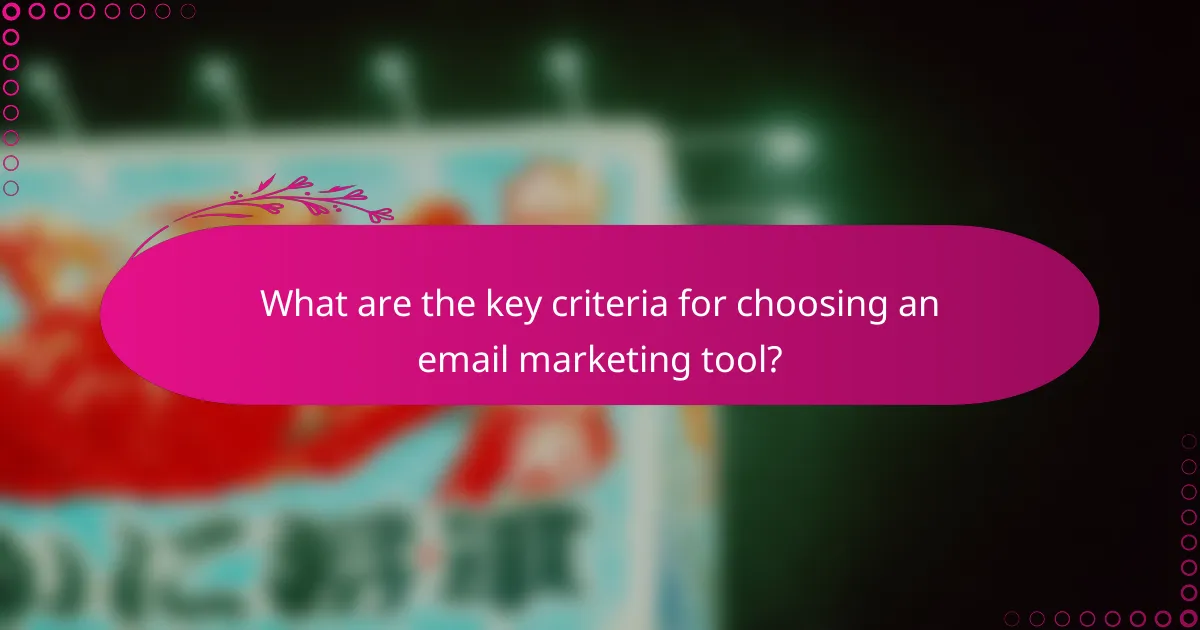Email marketing tools are essential for businesses looking to enhance their outreach through automation, analytics, and customizable templates. With automation features, marketers can efficiently engage their audience by sending timely messages based on specific triggers. Additionally, robust analytics dashboards provide valuable insights into campaign performance, enabling businesses to optimize their strategies for better engagement and results.

What are the best email marketing tools in Canada?
The best email marketing tools in Canada offer a range of features including automation, analytics dashboards, and customizable templates. These tools help businesses streamline their email campaigns, track performance, and create engaging content tailored to their audience.
Mailchimp
Mailchimp is a popular email marketing tool known for its user-friendly interface and robust automation features. It allows users to create automated email sequences based on user behavior, making it easier to engage with subscribers at the right time.
With a comprehensive analytics dashboard, Mailchimp provides insights into open rates, click-through rates, and audience engagement. This data helps businesses refine their strategies and improve campaign performance.
Mailchimp offers a variety of templates that can be easily customized to match branding. Users can choose from pre-designed options or create their own, ensuring that emails are visually appealing and effective.
Constant Contact
Constant Contact is designed for small to medium-sized businesses, offering powerful email marketing features with a focus on ease of use. Its automation capabilities allow for personalized email campaigns based on customer interactions, which can significantly enhance engagement.
The analytics dashboard in Constant Contact provides essential metrics such as bounce rates and subscriber growth, helping businesses track their email marketing effectiveness. Users can also segment their audience for targeted campaigns.
Constant Contact provides a wide range of customizable templates, making it simple to create professional-looking emails. The drag-and-drop editor allows users to easily modify designs without needing technical skills.
Sendinblue
Sendinblue combines email marketing with SMS campaigns, offering a versatile platform for businesses. Its automation features enable users to set up workflows that trigger emails based on specific actions, enhancing customer engagement.
The analytics dashboard in Sendinblue provides detailed reports on campaign performance, including delivery rates and engagement metrics. This helps businesses identify trends and optimize future campaigns.
Sendinblue offers a selection of responsive templates that can be tailored to fit various industries. Users can easily customize these templates to align with their branding and messaging.
ActiveCampaign
ActiveCampaign is known for its advanced automation capabilities, making it suitable for businesses looking to implement complex email marketing strategies. Users can create intricate workflows that respond to customer behavior, ensuring timely and relevant communication.
The analytics dashboard in ActiveCampaign provides in-depth insights into customer interactions, allowing businesses to track engagement and conversion rates effectively. This data is crucial for refining marketing strategies.
ActiveCampaign offers a variety of templates that are easily customizable. Users can create visually appealing emails that resonate with their audience, enhancing overall effectiveness.
AWeber
AWeber is a reliable email marketing tool that focuses on simplicity and effectiveness. Its automation features allow users to set up autoresponders that send emails based on subscriber actions, helping maintain engagement over time.
The analytics dashboard in AWeber provides essential metrics, including subscriber growth and email performance. This information helps businesses assess their email marketing efforts and make necessary adjustments.
AWeber provides a range of customizable templates, ensuring that users can create professional emails that reflect their brand. The platform also offers a selection of pre-designed templates for quick setup.

How does email automation work?
Email automation streamlines the process of sending emails based on specific triggers or schedules, allowing businesses to engage with their audience efficiently. By setting up automated workflows, marketers can deliver timely and relevant content without manual intervention.
Triggered campaigns
Triggered campaigns are automated emails sent in response to specific actions taken by users, such as signing up for a newsletter or abandoning a shopping cart. These emails are designed to engage users at critical moments, increasing the likelihood of conversion.
To implement triggered campaigns effectively, identify key user actions and set up corresponding email responses. For example, if a customer leaves items in their cart, an automated reminder email can be sent within a few hours to encourage completion of the purchase.
Drip campaigns
Drip campaigns involve a series of automated emails sent over time to nurture leads or guide customers through a journey. These emails are usually pre-scheduled and focus on delivering valuable content at regular intervals.
When creating a drip campaign, consider the customer lifecycle stages and tailor your messages accordingly. For instance, a welcome series for new subscribers might include an introductory email followed by tips on using your product, spaced a few days apart.
Segmentation
Segmentation is the practice of dividing your email list into smaller groups based on specific criteria, such as demographics, behavior, or purchase history. This allows for more targeted and relevant email automation, improving engagement rates.
To effectively segment your audience, analyze your data and identify key characteristics that influence user behavior. For example, you might create segments for first-time buyers, repeat customers, or users who have shown interest in specific product categories, enabling you to tailor your messaging to each group.

What analytics features should I look for?
When choosing an email marketing tool, focus on analytics features that provide insights into your campaign performance. Key metrics like open rates, click-through rates, and conversion tracking are essential for understanding engagement and optimizing future campaigns.
Open rates tracking
Open rates tracking measures the percentage of recipients who open your emails, providing insight into the effectiveness of your subject lines and sending times. A typical open rate can vary widely, often ranging from 15% to 30% depending on the industry.
To improve open rates, consider A/B testing different subject lines and sending times. Avoid spammy language and ensure your emails are mobile-friendly, as many users check emails on their phones.
Click-through rates
Click-through rates (CTR) indicate the percentage of recipients who clicked on links within your email. This metric is crucial for assessing how well your content and calls to action resonate with your audience, with average CTRs generally falling between 1% and 5%.
To enhance CTR, use clear and compelling calls to action, and ensure your links are easily accessible. Segmenting your audience can also help tailor content that drives higher engagement.
Conversion tracking
Conversion tracking measures the percentage of email recipients who complete a desired action, such as making a purchase or signing up for a newsletter. This metric is vital for evaluating the overall effectiveness of your email campaigns in driving business goals.
Implementing conversion tracking often involves setting up goals in your analytics platform and linking them to your email campaigns. Ensure you follow up with targeted emails to nurture leads and encourage conversions, as this can significantly boost your overall success rate.

What template options are available?
Email marketing tools typically offer a variety of template options to help users create visually appealing and effective campaigns. These templates can range from responsive designs to industry-specific layouts, allowing marketers to tailor their messages to different audiences and objectives.
Responsive templates
Responsive templates automatically adjust their layout based on the device used to view them, ensuring optimal readability on smartphones, tablets, and desktops. This adaptability is crucial as a significant portion of email opens occurs on mobile devices. When selecting a responsive template, check that it maintains visual integrity across various screen sizes.
Customizable designs
Customizable designs allow users to modify colors, fonts, and layouts to align with their brand identity. Many email marketing tools provide drag-and-drop editors that simplify the customization process. When using these designs, ensure that your changes enhance clarity and maintain a professional appearance, avoiding overly complex layouts that may confuse recipients.
Industry-specific templates
Industry-specific templates cater to the unique needs of different sectors, such as retail, healthcare, or real estate. These templates often include relevant imagery and content structures that resonate with target audiences. When choosing an industry-specific template, consider how well it aligns with your brand message and whether it includes necessary compliance features, especially in regulated industries like finance or healthcare.

What are the key criteria for choosing an email marketing tool?
When selecting an email marketing tool, focus on automation features, analytics capabilities, and template options. These criteria directly impact the effectiveness of your campaigns and user engagement.
Integration capabilities
Integration capabilities are crucial for ensuring your email marketing tool works seamlessly with your existing systems, such as CRM software and e-commerce platforms. Look for tools that offer native integrations or easy-to-use APIs to connect with popular services like Salesforce, Shopify, or WordPress.
Consider the ease of setting up these integrations. Some tools provide pre-built connectors, while others may require custom development, which can increase costs and time. Always check for compatibility with your current tech stack before making a decision.
Pricing plans
Pricing plans vary widely among email marketing tools, often based on features, the number of subscribers, or the volume of emails sent. Most platforms offer tiered pricing, allowing you to choose a plan that fits your budget and needs, typically ranging from free options for small lists to premium plans for larger businesses.
Evaluate what each plan includes, such as automation features, analytics dashboards, and template options. Some tools may have hidden fees for additional features or support, so read the fine print and consider your long-term growth when selecting a plan.
